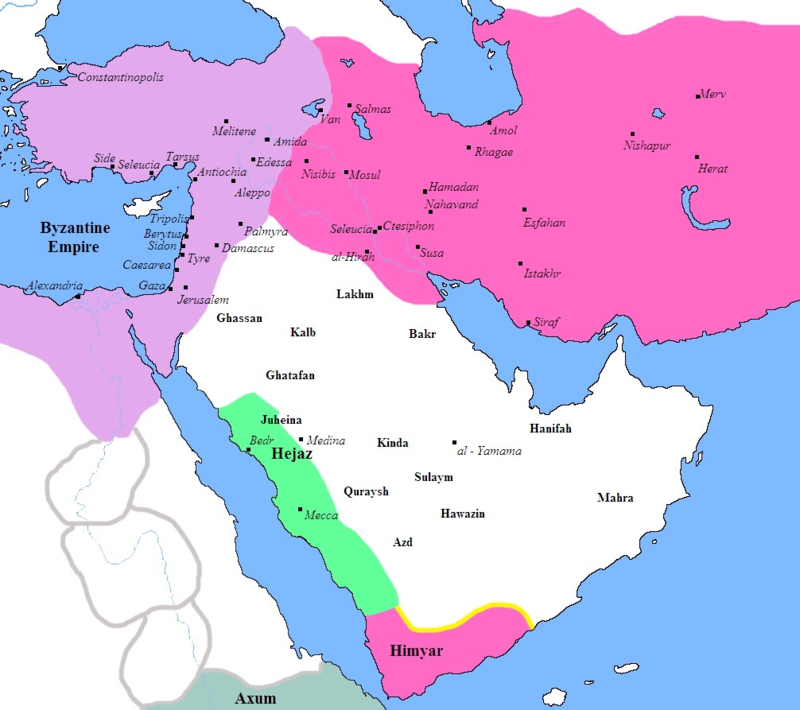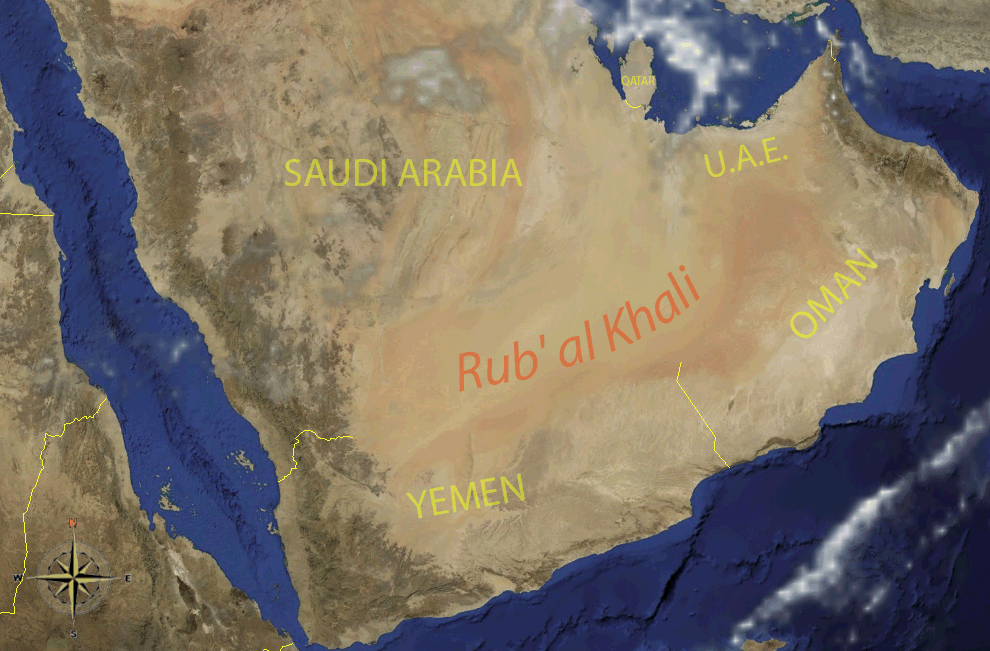The Arabian Peninsula is a peninsula that just out between north eastern Africa and the Middle East. Created by the effects of tectonic plates in the region it was originally joined to both the aforementioned regions. Even then the Red Sea & the Persian Gulf & the Gulf of Oman wasn't as high as they were filling in more with sea water over time. Indeed, modern research shows that early humans had crossed the area now covered by the Red Sea before it was covered in water.
Geography
It is usually split into four distinct regions: the Central Plateau (Najd or Al-Yamama), South Arabia, Al-Bahrain (Eastern Arabia or Al-Hassa), and the Hejaz (Tihamah for the western coast. The majority of the region is desert and arid scrubland. A few oases exist and the very odd water course. Mountains & mountain ranges primarily are found in the south west, and these have a higher rainfall than the rest of the peninsula. Harrat ash Shaam is a large volcanic field that extends from northwestern Arabia into Jordan and southern Syria, and means Black Desert.
Other features are:
- A central plateau, the Najd, with fertile valleys and pastures used for the grazing of sheep and other livestock
- A range of deserts: the Nefud in the north, which is stony; the Rub' al Khali or Great Arabian Desert in the south, with sand estimated to extend 600 ft (180 m) below the surface; between them, the Dahna Mountains
- Stretches of dry or marshy coastland with coral reefs on the Red Sea side (Tihamah)
- Oases and marshy coast-land in Eastern Arabia, the most important of which are those of Al Ain (Tawam in the United Arab Emirates and Oman) and Al-Hasa (in Saudi Arabia), according to one author
- Tropical monsoon coastline in Dhofar and Al-Mahra (known as Khareef in the Arabian Peninsula).
- Northeast: The Hajar range, shared by the UAE and northern Oman
- Southeast: The Dhofar Mountains of southern Oman, contiguous with the eastern Yemeni Hadhramaut
- West: Bordering the eastern coast of the Red Sea are the Sarawat, which can be seen to include the Haraz Mountains of eastern Yemen, and the 'Asir and Hijaz Mountains of western Saudi Arabia, the latter including the Midian in northwestern Saudi Arabia
- Northwest: Aside from the Sarawat, the northern portion of Saudi Arabia hosts the Shammar Mountains, which include the Aja and Salma subranges
- Central: The Najd hosts the Tuwaiq Escarpment or Tuwair range.
Ecosystem
The desert conditions are primarily trapped in a desert ecosystem with slight spring conditions at regular intervals. Most of the plants & animals are found in the wadis and the fertile regions, with specialised organisms living in the deep desert that can survive in these conditions.
Ecosystem Cycles
Primarily summer conditions exist throughout the region, and will have spring conditions around the time of the turn of the year bring in slightly higher rainfall.
Localized Phenomena
Sudden storms can roll off the seas surrounding the Peninsula and can easily turn thunderous, along with sandstorms in the desert regions.
Though not volcanic in nature the Peninsula sits on it's own tectonic plate called the Arabian Plate, so earthquakes can appear regularly depending on the force of the movement behind it.
In the Empty Quarter ferocious sandstorms with thunder & lightning can occur in the depth of it, and thought of to be caused by spirits, especially the spirits of the Lost City of Iram. These are thought of to be the spirits of dead Jinn that inhabited the City of Pillars as the Giants & Humans were cursed to Hell.
Fauna & Flora
Many desert plants & animals exist in the Peninsula along with some that can make use of the plateau. Snakes are common, as well as desert mice, jackals, hawks, lions, crocodiles to a lesser degree, and plenty of different fish can be found. Palm trees & fruit trees are common, along with hardy grasses, and lily plants in some waterways. The desert worm is the most terrifying of all though, and found in the deep desert of the Empty Quarter. Crops are grown such as onions for example.
Natural Resources
Some old ruins are found throughout the mountains & deserts, along with prehistorical sites. Many religious sites are found dotted around, along with areas that have strong magical energies flowing through them.
Water is at a premium and almost worth the same as gold. Large oil deposits are found throughout parts of it too, along with the gas deposits too. In the mountains it is easier to mine and all manner of metal ores & gems can be found as well.
Because of it's location, the part of the Silk Road that relies on shipping relies heavily on it. Goods on ship can lay over in port before going south to eastern Africa, or back up to Persian, and can be loaded / unloaded here.
All the while there is the rumours of the Lost City of Iram that draws adventurers in looking to plunder it, and at the same time helping to map the interior. All the while the chitin of the desert worms are collected from the dead remains of the animals, whether from carcasses or by hunting them.
History
From the beginning, the Arabian Peninsula sits on it's own tectonic plate and has gradually moved more to the north from north east Africa. This has been happening over the course of millions of years, and led to the formation of the Red Sea & the Persian Gulf.
About 106,000 BC to 130,000 BC early humans started to encroach into the interior of the Peninsula and at the same time most would stick in sight of the coastline. Unbeknownst to early man, the region was inhabited over millions of years to dragons, giants, and the Jinn. Many of these had outposts & cities in the interior that were hard to get to by other races that eventually surfaced. The only races that did make it was the Yuan-Ti, the Jackalweres, and the Gnolls. Of these three, the Yuan-Ti are most dominant.
Eventually some of the human tribes started to combine forming the Bedouin. Some became nomads and others of them settled along the coast and in areas wit Wadis, rivers & lakes. At the same time they found the old ruins and settlements of the other races and begun plundering them, driving all before them until few were left hidden in inhospitable regions.
Humanity also splintered into more tribes, and clans, with the Semitic languages eventually being developed & splitting into their present forms. Religions had also sprung up with, pagan beliefs, then also Judaism, Christianity, and then Islam all in the Peninsula.
Tourism
The Peninsula contains both Jerusalem to the north west of it, and Mecca to the south east. Other religious sites are found throughout, and leads to religious tourism being highly important. At the same time many of the city states also have strong ties to the Silk Road where they can count on visitors following it.
"Ancient that place is. The whole Peninsula is rich in folk tales and history. The amount of empires that evolved there or entered it is truly amazing. None of the older empires survive though, thankfully.
If you go there the old religious sites are a must, and try the cuisine. All those spices are great. No alcohol though unless for medical reasons. And silks imported from Asia. Far better than the local versions & even more so than the European. Armour is another thing. Avoid heavy gear. Gets too hot, and keep plenty of water handy. Sandstorms & the heat is terrible if your not used to it.
Avoid the Empty Quarter though. Tales of lost cities & giant worms there, and the lack of support... terrible. And the stories too, of Jinn as they are called. To us, more like demons, devils, Little Folk, or spirits. Nothing like another class of creature to terrify the locals. All they need is an elemental to appear too."
Tonk the Tinker. Gnome artificer in Mecca.
Type
Peninsula
Included Organizations




Comments